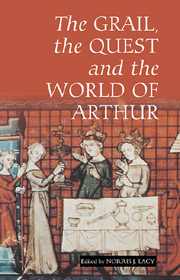Book contents
- Frontmatter
- Contents
- List of Illustrations
- Notes on Contributors
- Foreword
- Introduction: Arthur and/or the Grail
- 2 The Shape of the Grail in Medieval Art
- 3 The Crusaders' Grail
- 4 Bounds of Imagination: Grail Questing and Chivalric Colonizing in Wolfram von Eschenbach's Parzival
- 5 The Land without the Grail: A Note on Occitania, Rigaut de Barbezieux and Literary History
- 6 Female Desire and the Quest in the Icelandic Legend of Tristram and Ísodd
- 7 Questing in the Middle Dutch Lancelot Compilation
- 8 Keeping Company: Manuscript Contexts for Reading Arthurian Quest Narratives
- 9 Grail and Quest in the Medieval English World of Arthur
- 10 Malory and the Grail: The Importance of Detail
- 11 Glastonbury, the Grail-Bearer and the Sixteenth-Century Antiquaries
- 12 The Grail Quest: Where Next?
- Appendix: The Grail on Film
- Index
- Analysis of grail scenes
- Arthurian Studies
6 - Female Desire and the Quest in the Icelandic Legend of Tristram and Ísodd
Published online by Cambridge University Press: 05 February 2013
- Frontmatter
- Contents
- List of Illustrations
- Notes on Contributors
- Foreword
- Introduction: Arthur and/or the Grail
- 2 The Shape of the Grail in Medieval Art
- 3 The Crusaders' Grail
- 4 Bounds of Imagination: Grail Questing and Chivalric Colonizing in Wolfram von Eschenbach's Parzival
- 5 The Land without the Grail: A Note on Occitania, Rigaut de Barbezieux and Literary History
- 6 Female Desire and the Quest in the Icelandic Legend of Tristram and Ísodd
- 7 Questing in the Middle Dutch Lancelot Compilation
- 8 Keeping Company: Manuscript Contexts for Reading Arthurian Quest Narratives
- 9 Grail and Quest in the Medieval English World of Arthur
- 10 Malory and the Grail: The Importance of Detail
- 11 Glastonbury, the Grail-Bearer and the Sixteenth-Century Antiquaries
- 12 The Grail Quest: Where Next?
- Appendix: The Grail on Film
- Index
- Analysis of grail scenes
- Arthurian Studies
Summary
French romance was introduced to Norway in translation in the year 1226. The work in question was Thomas de Bretagne's Tristran, known in Old Norse as Tristrams saga ok Ísöndar. The saga, the only complete member of the Thomas branch of the Tristan legend, was translated at the behest of the Norwegian King Hákon Hákonarson (r. 1217–63) by a certain Brother Robert. Today the source text is extant solely in fragmentary form, while its other derivative text, Gottfried von Strassburg's Tristan, is incomplete. The Norwegian translation thus plays an extraordinary role in assessing the courtly version of the Tristan legend. Tristrams saga was followed by the translation of three of Chrétien de Troyes's romances, his Erec, Yvain and Perceval, the same three romances that were also the sources of German versions by Hartmannn von Aue and Wolfram von Eschenbach. Unlike the German versions, however, the Norse versions of Chrétien's romances did not generate indigenous Arthurian compositions in the North. Tristrams saga ok Ísöndar was a prolific source of motifs, however, not only for the riddarasögur, the Icelandic romances, an imported genre, but also for two Íslendingasögur, that is, Sagas of Icelanders.
In addition to the love-triangle motif, Icelandic authors of romance borrowed the ambiguous oath, the voyage for healing, the statue of the beloved and the abduction and restoration of the wife to her husband. Notable is the fact that when Tristan motifs were borrowed for the indigenous Icelandic romances, they remained the same. When Tristan motifs were incorporated into the Íslendingasögur, however, they underwent acculturation.
- Type
- Chapter
- Information
- The Grail, the Quest, and the World of Arthur , pp. 76 - 91Publisher: Boydell & BrewerPrint publication year: 2008



